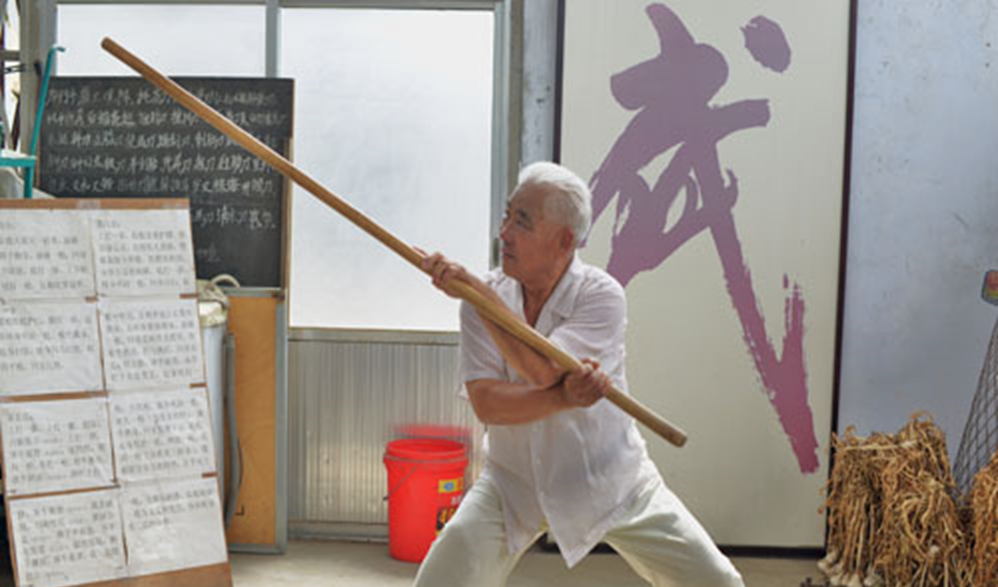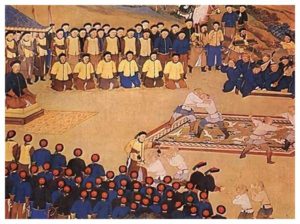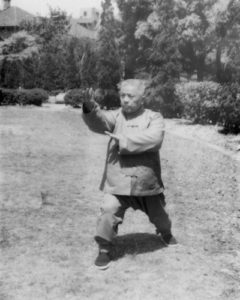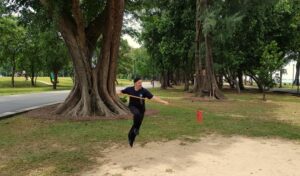Yantai is well known for its Mantis Boxing, and as part of the weapons in the system, it is common to find the Six Harmonies Staff (六合棍). This staff method is said to have been brought into the Mantis boxing world from practitioners in Nantushan village in Fushan district. In August, 2010 The Nantushan Liuhe Staff was entered into the official Yantai records and M Cheng Xianming (1937-) from Dongbie Guan Village, Fushan District, Yantai City, Shandong as a representative inheritor.
Cangzhou, the origin of the Liuhe Staff
Cheng Xianming explains that the Liuhe Staff was not from Nantushan but was brought into the village by a man called Yu Qiu (于秋) from Cangzhou in Hebei Province (where many great martial arts were practiced including Liuhequan (六合拳 Six Harmonies Boxing)). In the Chongwen (1628-1644) period of the Ming Dynasty, a resident of Nantushan, Yu Erzhi travelled to Cangzhou and whilst in an Inn helped a man escape from the authorities. This man called Qiu later returned with Yan Erzhi to Nantushan and together that taught the Staff methods to Yu Erzhi’s grand son, whom showed great dedication and skills in its practice. As a result Yu Qiu taught the complete staff methods and from then on, the Nantushan Six Harmomies staff legacy commenced.
Yu Family Legacy
This Six Harmonies staff was kept secret within the Yu Family of the Nantushan village for generations. It wasn’t until the Qianlong (1711-1799) period of the Qing dynasty, that Yu Yi taught the staff outside the family. Yu Yi at the time also wanted to enhance the family’s martial arts and sought to exchange with Boxing masters. It is at that time that Liang Xuexiang, the famed Master of Praying Mantis Boxing exchanged the Beng Bu Mantis Boxing method for the Six Harmony Staff. A local folklore explains that in the past Nan Tu Shan would select the best fighters to protect the village and their recognition so great that it was said “As long as the 36 fighters come down the mountain, all under heaven would be in Peace”. Unfortunately after martial expert from Cangzhou came to the village challenging the best fighters with his short stick, defeating every single one of the them. The village became very disheartened. One of the village expert stick fighters, Yu Peisheng was away on business and after hearing the news returned. Yu Peisheng defeated the short stick fighter with ease and the reputation of the Nantushan Yu Family stick was restored and continues until this day.
Six Harmonies Staff Method
The Six Harmonies Staff consists of Six rounds (sequences) with 110 movements in total. Each of the movements or techniques have specific names and essential requirements. The techniques must be practiced clearly without any omissions, it is a complete Staff system. The Method has many features in accord with both the staff and the spear and it is often said that within the Staff the Spear is hidden. The Six harmonies staff clearly divides Yin and Yang, integrates Bagua theories, Clearly separates the full and empty, there are effective methods of entering and retreating. It is very lively and agile, with a large variety in techniques. Those together with the Body methods, Stepping, Bravery and the physical skills allow practitioners to achieve great Staff skills. To ensure effectiveness, the staff used in the method is the White Wax wood eyebrow height staff. There are six staff methods Tiao (pick), Ci (Stab), Pi (Axe), Liao (Lift up), Sao (sweep), Jiao (Cross) and the variations of those with confusing changes and linking methods allows the Six Harmonies staff to come alive. As it is said in Northern circles ” The Spear pokes along the straight line, whilst the staff strikes across a large area”.
Ensuring the true transmission of the Six Harmonies Staff Cheng Xianming had studied Praying Mantis boxing with Che E’ting and Su Kebin. He learnt the Six Harmonies staff from Zhang Baolu and Luan Hongcheng. Cheng Xianming told of the story how he loved martial arts from a young age and in those days to become a army cadet he started to train the Six Harmonies staff. Since real combat skills were necessary, he thought the study of Six Harmonies staff would be most useful. But at the time the Stick method was not taught to outsiders. So he followed a young boy from the Nantushan Villiage and became friends and the young boy would take the family’s Boxing Manual out. So in this way the methods would be in line with the requirements noted in the boxing manual. This way rather than have variations of the staff methods, it would ensure that the techniques would remain true to their original skilled design. M Cheng was an industrious student and was not satisfied with both the transmission and alignment to the boxing manual He later followed Fushan’s Yang Jingtang’s disciple to further his research on the Six Harmonies Staff.
Source: 南涂山六合棍入选市级非物质文化遗产名录




